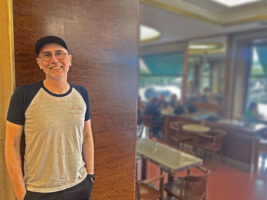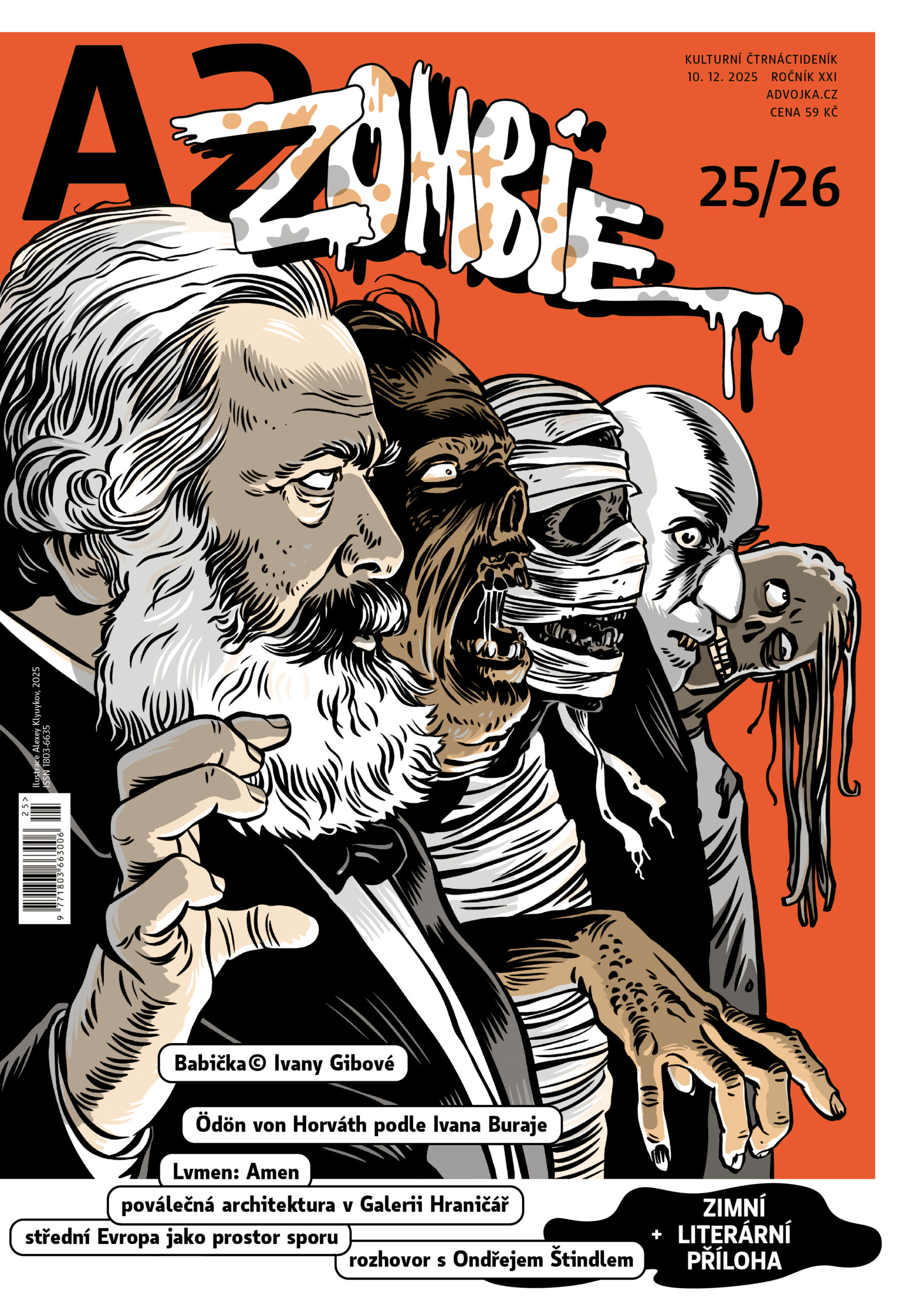Fight for the pigsty
The past and memory of the concentration camp Lety
The pigsty in Lety near Písek has become the icon of the Romani holocaust memory. A host of clashes, conflicts, and questions remain in the shadows of the plant for the “meat production,” even though there are talks that it will now be finally, finally torn down. Even if this actually happens, the issues will not easily disappear.

The Lety concentration camp was set up in a village near Písek in 1940 per the decision of the 2nd Republic government about „punitive work camps“ where the long-term unemployed were to undergo a Czech version of three-month hard labor.
The camp gradually changed its purpose, though not its staff: and so Czech police officers supervised by Josef Janovský became temporary masters over life and death of over one thousand Roma, including women and young children. More than three hundred of the involuntary inhabitants of the camp (the total number was thirteen hundred) fell victim to cruel treatment or typhus epidemic that broke out as a result of horrid hygienic conditions, extreme crowding of the camp, but also Czech guards stealing food from the prisoners. Those prisoners who survived were sent to death to Auschwitz.
Forgotten past
Practically no one was convicted for this Czech contribution to the Romani holocaust. Even sadist Janovský was eventually acquitted. Only guard Josef Luňáček was punished for cruelty toward prisoners. He was reprimanded. From approximately 6 500 Czech Roma only a few hundred survived the war. This was, in relative numbers, possibly the most successful case of Nazi genocide of the Roma. We can only speculate if „success“ such as this would have been possible without ardent complicity of Czech police officers and the protectorate collaborate government.
Under the former regime, the Lety concentration camp was not publicly discussed, even if the information existed and the camp was sometimes written about. All the more attention it sparked in 1990s. The topic became an international moral scandal commented on by everyone, one of the many battlegrounds between history and memory, as Tomáš Sniegoň has shown in Vanished History (Zmizelá historie, 2016). It is important to say that the most visible protagonists embodied to nearly caricatural proportions all negative stereotypes there are about activist and irresponsible memory on the one side and seemingly detached and in reality apologetic history on the other side.
American genealogist Paul Polansky who has ensured Lety’s international publicity has become a controversial hero of the fighters for accepting the Czech guilt and removal of the pigsty. Even his first article’s title, noting „thousands of murdered Roma“ was an exaggeration. While conducting research on the southern bohemian ancestors of his contemporary American families, Polansky was shocked by Czech racism and it was the case of Lety that he understood as its telling symbol. Making use of a translator, Polansky wrote down about hundred interviews with those who remembered the times (and who all allegedly refused to be recorded, which made any future verification impossible), and wrote several publications about his scandalous discoveries: a collection of interviews, poems, and a novel Bouře. The novel also included an explanation of the reasons his work received such poor reception: The father of the influential chancellor, count Schwarzenberg was to have profited from the prison labor and
President Havel’s half-brother, the illegitimate child of the powerful ruler of the Prague Lucerna, was allegedly among the cruel guards. The mysteries surrounding his novel include that all copies were allegedly completely destroyed by the 2002 flood. The American showman has received far more attention than German sociologist and activist Markus Pape whose fact-based book, A nikdo vám nebude věřit (1997) combined serious approach with courageous questions.
Polansky was shooting from the hip and didn’t overly concerned himself with facts or numbers. He was luring his readers into fictional genres where he promised to tell the „whole truth,“ even as he was using author’s license. It’s exactly some of his factual slips and author manipulations that gave his opponents a chance to belittle his critique of Czech society. The amateur interest and activism was to be replaced by strict historical science. But that fared even worse than the fact-overwriting activism.
Nation-defending historiography
Historian Ctibor Nečas has become a leading expert on Romani genocide in the Czech Republic. But he represents a rather dry descriptive approach based in the sources by the perpetrators located in the Třeboň archive. His critics claim that he didn’t adequately utilize the recollections of the victims (his interviews focused more on Auschwitz than Lety), and didn’t draw enough on other archival sources, including court trials with the guards that took place in the aftermath of ww2. This resulted in a descriptive account that reproduces the long winding bureaucratic style of the concentration camp and does not ask too many questions about connections and responsibilities.
But worse yet, in 1999 Nečas allowed his findings to be framed by Jaroslav Valenta in a booklet Historikové a kauza Lety, distributed to the members of the parliament as revelation of „historical truth“ to the entire cause, even as this was a rather nation-defending pamphlet. The framing of the pamphlet enabled politicians to downplay the significance of the camp. In this sense, president Václav Klaus argued in 2005: „This isn’t a true concentration camp in the sense of how we all understand the term and visualize Auschwitz, Buchenwald, and similar.” Communist party MP Miloslav Ransdorf claimed: “As a historian, I know there are plain lies surrounding Lety. There wasn’t any true concentration camp there.”
The Lety Curse
But the main argument wasn’t about disproving the character of the camp, but about money. There probably wouldn’t be government that could defend the hundreds of millions that would need to be spent on the relocation of the pigsty to the majority, and most likely even some Roma that could as well ask why the money isn’t rather spent on pulling the living out of the ghetto trappings. And so the dispute in the unchanged props of the pigsty (privately owned since 1994) has moved into the new millennium. In addition to annual ceremonies, the site with the humiliating silhouette in the background has occasionally witnessed a bit of stir – that happened when Roma leaders made it clear that they refused to cooperate with the establishment or when anti-racist activists concluded that the situation of contemporary Roma will not move forward if the pigsty remains located on the site of their ancestors‘ suffering and launched a campaign complete with a blockade. New faces and initiatives have been getting
incorporated into the dispute, but it is as if parts of the 1990s curse would continuously be reiterated. The apologism on the one side, words such as “Lety was not a concentration camp, it was a collecting camp“, which you also hear from the guides at the exhibition on Lety. There is now a memorial in Lety, but it part if and supervised by the Lidice Memorial. This is more than symbolic: the suffering caused to the Roma by protectorate Czech officers was placed under Czech suffering and Czech national story.
On the other hand, there is the attempt to formulate an almost metaphysical Czech guilt, so pronounced among many human rights activists and campaigns of the Konexe association and Antifašistická akce. Lety has become a rather accessible stone that can be thrown at the consciousness of the majority or shortcut for a solution of contemporary issues through the past and memory. Both initiatives seek to undermine nationalism but by focusing on some sort if metaphysical national guilt inherited from ancestors, they underscore its preconditions instead.
If we follow the more-than-twenty-year-long fight over the pigsty p, it is hard to not be skeptical, when we hear the how many times repeated proclamations that it will be removed. But even if this were to happen, there are far more essential underlying questions: How to appropriately pay tribute to the victims and relate it to the present without cheap amendments. How to avoid belittling Czech guilt and cheap moralizing?
The author is political scientist and journalist.
Translated by Dagmar Frančíková.




